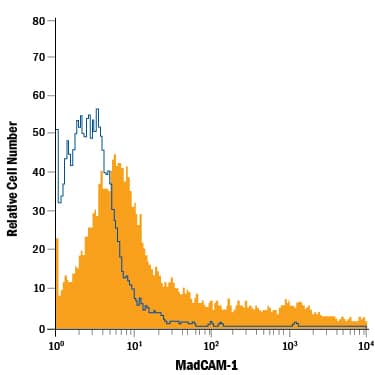Human MAdCAM-1 APC-conjugated Antibody
R&D Systems, part of Bio-Techne | Catalog # FAB6056A


Conjugate
Catalog #
Key Product Details
Species Reactivity
Validated:
Human
Cited:
Human
Applications
Validated:
Flow Cytometry
Cited:
Flow Cytometry
Label
Allophycocyanin (Excitation = 620-650 nm, Emission = 660-670 nm)
Antibody Source
Monoclonal Mouse IgG1 Clone # 683715
Product Specifications
Immunogen
Mouse myeloma cell line NS0-derived recombinant human MAdCAM-1
Leu21-Gln333
Accession # AAY82472
Leu21-Gln333
Accession # AAY82472
Specificity
Detects human MAdCAM-1 in direct ELISAs.
In direct ELISAs, no cross-reactivity
with recombinant mouse MAdCAM-1, recombinant human (rh) ALCAM, rhBCAM,
rhCEACAM-1, rhEpCAM, rhICAM-1, -2, -3, -4, -5, rhCD31/PECAM-1, or rhVCAM-1 is
observed.
Clonality
Monoclonal
Host
Mouse
Isotype
IgG1
Scientific Data Images for Human MAdCAM-1 APC-conjugated Antibody
Detection of MAdCAM-1 in HeLa Human Cell Line by Flow Cytometry.
HeLa human cervical epithelial carcinoma cell line was stained with Mouse Anti-Human MAdCAM-1 APC-conjugated Monoclonal Antibody (Catalog # FAB6056A, filled histogram) or isotype control antibody (Catalog # IC002A, open histogram). View our protocol for Staining Membrane-associated Proteins.Applications for Human MAdCAM-1 APC-conjugated Antibody
Application
Recommended Usage
Flow Cytometry
10 µL/106 cells
Sample: HeLa human cervical epithelial carcinoma cell line
Sample: HeLa human cervical epithelial carcinoma cell line
Formulation, Preparation, and Storage
Purification
Protein A or G purified from hybridoma culture supernatant
Formulation
Supplied in a saline solution containing BSA and Sodium Azide.
Shipping
The product is shipped with polar packs. Upon receipt, store it immediately at the temperature recommended below.
Stability & Storage
Store the unopened product at 2 - 8° C. Do not use past expiration date. Protect from light.
Background: MAdCAM-1
References
- Ando, T. et al. (2007) BMC Physiol. 7:10.
- Dando, J. et al. (2002) Acta Crystallogr. D 58:233.
- Leung, E. et al. (1996) Immunol. Cell Biol. 74:490.
- Ambruzova, Z. et al. (2009) Hum. Immunol. 70:457.
- Tada, T. et al. (2008) Exp. Anim. 57:247.
- Volpes, R. et al. (1992) Hepatology 15:269.
- Connor, E.M. et al. (1999) J. Leukoc. Biol. 65:349.
- Ala, A. et al. (2001) Gut 49:3043.
- Yang, X.D. et al. (1997) Diabetes 46:1542.
Long Name
Mucosal Addressin Cell Adhesion Molecule 1
Alternate Names
MAdCAM1
Gene Symbol
MADCAM1
UniProt
Additional MAdCAM-1 Products
Product Documents for Human MAdCAM-1 APC-conjugated Antibody
Product Specific Notices for Human MAdCAM-1 APC-conjugated Antibody
For research use only
